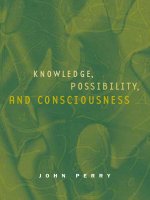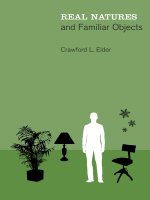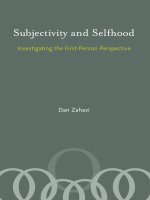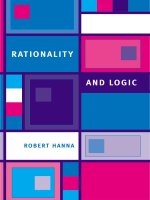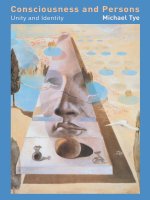the mit press consciousness and persons unity and identity nov 2003
Bạn đang xem bản rút gọn của tài liệu. Xem và tải ngay bản đầy đủ của tài liệu tại đây (1.54 MB, 219 trang )
Consciousness and Persons
Unity and Identity
Michael Tye
Consciousness and Persons
Unity and Identity
Michael Tye
In
Consciousness and Persons: Unity and Identity
Michael
Tye takes on the thorny issue of the unity of conscious-
ness and answers these important questions: What
exactly is the unity of consciousness? Can a single person
have a divided consciousness? What is a single person?
Tye argues that unity is a fundamental part of human
consciousness—something so basic to everyday experi-
ence that it is easy to overlook. For example, when we
hear the sound of waves crashing on a beach and at the
same time see a red warning flag, there is an overall
unity to our experience; the sound and the red shape are
presented together in our consciousness. Similarly, when
we undergo a succession of thoughts as we think some-
thing through, there is an experience of succession that
unifies the thoughts into a conscious whole. But, Tye
shows, consciousness is not always unified. Split-brain
subjects, whose corpus callosum has been severed, are
usually taken to have a divided or disunified conscious-
ness. Their behavior in certain situations implies that they
have lost the unity normal human subjects take for grant-
ed; it is sometimes even supposed that a split-brain sub-
ject is really two persons.
Tye begins his account by proposing an account of
the unity of perceptual experience at a single time; this
account is extended over the succeeding chapters to
cover bodily sensations at a single time and perceptual
experiences, bodily sensations, conscious thoughts, and
felt moods at a single time. Tye follows these chapters
with a discussion of the unity of experience through time.
Turning to the split-brain phenomenon, he proposes an
account of the mental life of split-brain subjects and
argues that certain facts about these subjects offer fur-
ther support for his theory of unity. Finally, addressing
“It would be impossible not to learn from this outstanding book. Michael Tye
displays real insight into the problems of unity and identity, and an intimidating
mastery of the relevant philosophical and psychological literature. But almost
as important, its brevity and clarity make the book a pleasure to read.”
—Frank Jackson, The Australian National University
“Not just another book on consciousness! This one is about various kinds of
unity (and a few disunities) in phenomenal experience. Provocative claims are
defended, and the presentation is lucid and engaging throughout. I especially
recommend Tye’s chapter on the specious present.”
—William G. Lycan, William Rand Kenan, Jr. Professor of Philosophy, University
of North Carolina
“Tye presents a compelling, original, philosophically sophisticated theory of the
unity of phenomenal consciousness without ever getting bogged down in philo-
sophical trench warfare.”
—Brian P. McLaughlin, Department of Philosophy, Rutgers University
“This short volume is full of good philosophy. Michael Tye raises new questions
about the unity of experience, and his answers cast important light on personal
identity. All philosophers working on consciousness or personhood should read
this book.”
—David Papineau, Department of Philosophy, King’s College London
Cover image: Salvador Dalí,
Apparition of the Visage of Aphrodite
. © 2003 Salvadore Dalí,
Gala-Salvadore Dalí, Foundation/Artists Rights Society (ARS), New York
The MIT Press
Massachusetts Institute of Technology
Cambridge, Massachusetts 02142
0-262-20147-X
,!7IA2G2-cabehg!:t;K;k;K;k
the topic of the nature of persons and personal identity,
Tye finds the two main historical accounts—the ego
theory and the bundle theory—lacking, and he makes an
alternative proposal. He includes an appendix on the
general representational approach to consciousness and
its many varieties, because of the relevance of represen-
tationalism to the theory of unity being advanced.
Michael Tye is Professor of Philosophy at the University
of Texas at Austin.
Consciousness and the Mind series
A Bradford Book
Consciousness and Persons
Tye
Tye_cover2 12/1/03 1:35 PM Page 1
Consciousness and
Persons
Representation and Mind
Hilary Putnam and Ned Block, editors
Representation and Reality Hilary Putnam
Explaining Behavior: Reasons in a World of Causes Fred Dretske
The Metaphysics of Meaning Jerrold J. Katz
A Theory of Content and Other Essays Jerry A. Fodor
The Realistic Spirit: Wittgenstein, Philosophy, and the Mind Cora Diamond
The Unity of the Self Stephen L. White
The Imagery Debate Michael Tye
A Study of Concepts Christopher Peacocke
The Rediscovery of the Mind John R. Searle
Past, Space, and Self John Campbell
Mental Reality Galen Strawson
Ten Problems of Consciousness: A Representational Theory of the Phenomenal
Mind Michael Tye
Representations, Targets, and Attitudes Robert Cummins
Starmaking: Realism, Anti-Realism, and Irrealism Peter J. McCormick (ed.)
A Logical Journey: From Gödel to Philosophy Hao Wang
Brainchildren: Essays on Designing Minds
Daniel C. Dennett
Realistic Rationalism Jerrold J. Katz
The Paradox of Self-Consciousness José Luis Bermúdez
In Critical Condition: Polemical Essays on Cognitive Science and the Philosophy
of Mind Jerry Fodor
Mind in a Physical World: An Essay on the Mind-Body Problem and Mental
Causation Jaegwon Kim
Oratio Obliqua, Oratio Recta: An Essay on Metarepresentation François
Recanati
The Mind Doesn’t Work That Way Jerry Fodor
Consciousness, Color, and Content Michael Tye
New Essays on Semantic Externalism and Self-Knowledge Susana Nuccetelli
Consciousness and Persons: Unity and Identity Michael Tye
Consciousness and
Persons
Unity and Identity
Michael Tye
A Bradford Book
The MIT Press
Cambridge, Massachusetts
London, England
© 2003 Massachusetts Institute of Technology
All rights reserved. No part of this book may be reproduced in any form by
any electronic or mechanical means (including photocopying, recording, or
information storage and retrieval) without permission in writing from the
publisher.
This book was set in Sabon by UG/GGS Information Services, Inc. and
was printed and bound in the United States of America.
Library of Congress Cataloging-in-Publication Data
Tye, Michael.
Consciousness and persons: unity and identity / Michael Tye.
p. cm.—(Representation and mind)
“A Bradford book.”
Includes bibliographical references and index.
ISBN 0-262-20147-X (hc.: alk. paper)
1. Consciousness. 2. Whole and parts (Philosophy). I. Title. II. Series.
B808.9.T935 2003
126—dc21
2002040999
10987654321
For Lauretta, Cecily, and Claudia
Contents
Preface xi
Introduction: Kinds of Unity and Kinds of
Consciousness 1
I.1 Preliminary Remarks 1
I.2 Cases of Consciousness (or Its Absence) 2
I.3 Kinds of Consciousness 5
I.4 Kinds of Unity 11
1 The Unity of Perceptual Experience at a Time 17
1.1 Multiple Experiences and the Problem of Unity 17
1.2 Undermining the Problem as Standardly
Conceived 21
1.3 The One Experience View 25
1.4 An Account of Synchronic Phenomenal Unity 36
2 The Body Image and the Unity of Bodily
Experience 43
2.1 The Body Image 43
2.2 A Theory of Bodily Sensations 49
2.3 The Problem of Bodily Unity 62
3 The Unity of Perceptual and Bodily Experiences,
Occurrent Thoughts, and Moods 67
3.1 Opening Remarks 67
3.2 Perceptual Consciousness and Experience of the
Body 68
3.3 Unity and Conscious Thoughts 78
3.4 Unity and Felt Moods 81
4 The Unity of Experience through Time 85
4.1 Examples of Unity through Time 85
4.2 The Specious Present and the Problem of Diachronic
Unity 86
4.3 An Account of Unity through Time 95
4.4 Some Mistakes, Historical and Contemporary 102
4.5 Carnap and the Stream of Consciousness 106
5 Split Brains 109
5.1 Results of Splitting the Brain 109
5.2 Multiple Personality Disorder, Split Brains, and
Unconscious Automata 113
5.3 Indeterminacy in the Number of Persons 117
5.4 Disunified Access Consciousness 121
5.5 Disunified Phenomenal Consciousness: Two
Alternatives 126
5.6 The Nontransitivity of Phenomenal Unity 129
6 Persons and Personal Identity 133
6.1 The Ego Theory and the Bundle Theory Quickly
Summarized 133
6.2 Objections to the Ego Theory 134
6.3 Objections to the Bundle Theory 138
6.4 A New Proposal 140
6.5 Problem Cases 143
6.6 Vagueness in Personal Identity 154
viii Contents
Appendix: Representationalism 165
Notes 177
References 187
Index 195
Contents ix
Preface
Some philosophers like to publish large, dense books. I do
not. The simple fact is that large philosophy books are rarely
read carefully. This is especially true if the books are hard
going, as more often than not they are. Philosophers usually
take great care in stating their positions; but, in my experi-
ence, they have less patience when they read others. I am no
different in this regard. My attention span is limited. I don’t
like having to work hard at trying to understand what the
book or article I am reading is saying. I want clarity and,
where possible, brevity.
The present book is written for those who share my pref-
erences. Its chapters are divided into numbered sections,
typically only a paragraph or two long. The book is clear, I
hope, both in structure and content. And it is relatively
short. There are even a few cartoons and illustrations to pro-
vide some light relief. The issues the book addresses, how-
ever, are not light or easy. They have taxed some of the
greatest philosophers of the past, and they are slippery and
confusing.
This is the third book I have written at least partly on con-
sciousness and it may well be asked how many is enough.
I concede that three seems excessive, especially given the
veritable explosion of books on consciousness in the last ten
years. But excess is not always a bad thing, even if we agree
that Oscar Wilde and William Blake went a little over the
top when they commented (respectively), “Nothing suc-
ceeds like excess” and “The road of excess leads to the
palace of wisdom.” Still, it was an epiphany, rather than a
qualified respect for excess, that led to the present work.
The epiphany occurred a couple of years ago, as I was sit-
ting in my garden, having a drink late in the afternoon. (The
drink, as I recall, was not alcoholic, as some have supposed.)
The air was heavy, there were sounds of birds calling to one
another, bees buzzing around nearby flowers, the smell of
damp grass, a profusion of colors. What struck me with
great intensity was the unity in my experience, the way in
which my experience presented all these things to me
together. What also struck me was that remarkably this unity
hadn’t really struck me before, that it was as if I had failed to
notice it!
Unity is a fundamental part of our experience, something
that is crucial to its phenomenology. It is so fundamental, so
much a part of our everyday consciousness, that it is easy to
overlook. And this, I speculate, is why more has not been
written about it in the recent vigorous debate about phe-
nomenal consciousness. Be that as it may, unity is an impor-
tant topic that connects both with empirical studies in
psychology of people with split brains and with the theoret-
ical, philosophical issue of personal identity.
The book begins with an introduction to the topics of
unity and consciousness. Different kinds of unity and con-
sciousness are distinguished, largely to help avoid misun-
derstanding as to the scope of the theory that follows.
Chapter 1 is concerned to undercut one standard way of
thinking about unity for the case of perceptual experience at
xii Preface
a single time and to offer an alternative account. Chapter 2
extends this account to the case of bodily sensations at a sin-
gle time; in the course of so doing, it provides a theory of
these sensations. This theory is compatible with my past
proposals on bodily sensations (e.g., in Tye 1995a) but it
goes beyond them in important ways. Chapter 3 extends the
account of unity still further to cover unity for perceptual
experiences, bodily sensations, conscious thoughts, and felt
moods, again at a single time.
Chapter 4 takes up the knotty issue of the unity of experi-
ence through time. Some historical proposals are considered
here and a new theory developed. Chapter 5 turns to the
case of people whose corpus callosum has been severed,
thereby splitting the two hemispheres of the brain. On the
basis of the anomalous behavior such individuals exhibit in
special experimental settings, they are usually taken to have
a divided or disunified consciousness. Sometimes, it is sug-
gested that they are really two persons. An account is pro-
posed and defended of the consciousness of split-brain
patients, and it is argued that certain facts about these patients
supply further support for the theory of unity on offer.
Finally, in chapter 6, the nature of persons and personal
identity is discussed. Some connections are drawn between
the issue of identity and that of unity; the discussion also
provides further theoretical underpinning for some of the
claims about persons in chapter 5. The two great historical
theories of the nature of persons—the ego theory and the
bundle theory—are found lacking for various reasons, and a
new proposal is made. The last part of the chapter takes up
the difficult question of whether there can be indeterminacy
in personal identity. Here it proves necessary to dangle a toe
or two into the quicksand of vagueness; but, given the focus
of the book, I resist the temptation to go any deeper.
Preface xiii
In my last two books, I laid out and defended the repre-
sentationalist view of phenomenal character. That view is
directly relevant to the proposals made in this book.
However, it is not necessary to endorse the specific theory I
take of the phenomenal character of experience in order to
find my ideas on unity agreeable. Representationalism is a
very general theory. For example, it involves no direct com-
mitment to physicalism and it takes no direct stand on the
nature of content. Those who finds themselves attracted to
the representationalist view of phenomenal consciousness,
even if they are unpersuaded by the specific form of the
view I endorse, should still find the current proposals about
unity of value. Those who are disinclined to accept even a
nonreductive form of representationalism may nonetheless
find food for thought in the book; for the simple and appeal-
ing way in which representationalism comes to grips with
unity provides further reason to take the theory seriously.
Since it may not be fully clear just what the commitments
of representationalism are, I have included an appendix on
representationalism. This appendix locates my version of
representationalism within the space of alternative possible
accounts of the theory and it reminds the reader that repre-
sentationalism comes in many varieties.
I have given talks on chapters from the book at many
places in the United States and the U.K., and I am indebted to
a large number of people for helpful comments. I recall in
particular remarks by Bob Adams, Kati Balog, Alex Byrne,
David Chalmers, Jim Dye, Bob Hale, Shelley Kagan, Sean
Kelly, Bob Kuehns, Fiona Macpherson, David Pitt, Joseph
Raz, Stephen Read, Mark Sainsbury, Sydney Shoemaker,
Susanna Siegel, Charles Spence, Leslie Stevens, Daniel
Stoljar, Scott Sturgeon, Jerry Vision, and Crispin Wright.
I am also indebted to Jim Gibbs for drawing the cartoons.
xiv Preface
The material in the book is new with the exception of
part of the introduction, which incorporates (with revi-
sions) some of my “The Burning House,” in Conscious
Experience (1996), edited by T. Metzinger, and most of
section 5 in chapter 6, which draws on my “Vagueness and
Reality,” Philosophical Topics 28 (2001).
Preface xv
Introduction: Kinds of
Unity and Kinds of
Consciousness
I.1 Preliminary Remarks
The thesis that consciousness is necessarily or essentially
unified plays a central role in Descartes’s writings and also
in those of Kant. Descartes took this to have significant
implications for whether the mind is a material thing; for,
according to Descartes, consciousness is the essence of the
mind and any material entity is separable into distinct parts.
Kant wisely resisted any such inference. In his view, it is no
less puzzling how an immaterial entity without parts could
have a unified consciousness than a material entity with
parts or components acting together.
Recent work in neuropsychology on subjects whose brains
have been bisected seems to undercut the thesis that Descartes
and Kant shared. These subjects behave in ways that are often
taken to show that their consciousness is disunified. Some
contemporary philosophers (Dennett, for example) even hold
that consciousness is frequently disunified. What makes the
evaluation of claims such as these difficult is that there is no
one kind of consciousness and there is no one kind of unity.
I shall not attempt here to draw up an exhaustive list
of kinds of consciousness or unity. But it will be useful to
distinguish some common kinds, if the main focus of this
book is to be properly grasped. I begin by presenting a num-
ber of ordinary, everyday cases, in some of which we nor-
mally suppose that consciousness is present while in others
we deny it. The purpose of these cases is to distinguish
between several different kinds of consciousness. The dis-
tinctions I draw reflect how we ordinarily think about con-
sciousness. In this way, they are conceptual distinctions.
I.2 Cases of Consciousness (or Its Absence)
Case 1: The Distracted Philosopher
Walking along the road, I find myself lost in thought for sev-
eral hundred yards, as I make my way home. During this
time I manage to keep myself on the sidewalk, but I am not
conscious of how things look to me as I walk along. Later on,
I “come to” and realize that I have been walking for some
time without any real consciousness of my perceptions.
1
Case 2: The Bird-watcher
You and I are both bird-watchers. There is a bird singing in a
tree nearby. We both hear it, but only you initially are con-
scious of it by sight. You tell me exactly where to look, and I
stare at the right part of the right branch. My retinal image
is, let us suppose, just the same as yours when I stand in the
spot you are located and look in the same direction. But
I report to you that I am not visually conscious of any bird.
2
Case 3: The Wine Taster
Apprentice wine tasters are much less discriminating than
experts. Through training they come to discriminate flavors
2 Introduction
that initially seemed to them to be the same. They become
conscious of subtle differences in wines of which they were
not previously conscious.
Case 4: The Brief Encounter
You are looking at a shelf on which there are eighteen books.
Your eyes quickly pass over the entire contents of the
shelf. You see more than you consciously notice. Indeed,
you see all the books (let us suppose). But you are not con-
scious of how each of the books looks.
Case 5: The Headache That Won’t Go Away
You have a bad headache, which lasts all afternoon. From
time to time during the afternoon, there are distractions.
You think of other things, you forget for a few moments. In
short, you are not always conscious of your headache.
When this happens, we do not infer that really you had one
headache that ceased at the first distraction, then another
quite different headache until the next distraction, so that
you were really subject to a sequence of discontinuous
headaches.
3
Case 6: The Pain in the Night
I am fast asleep. During the night I am awoken by a pain of
which, before awakening, I was not conscious.
4
Case 7: What It Is Like
I smell a cigar smoldering; I feel a burning pain in my stom-
ache; I taste some smoked salmon; I seem to see bright yel-
low. In each of these cases, I undergo a different feeling or
Kinds of Unity and Kinds of Consciousness 3
experience. For feelings and perceptual experiences, there is
always something it is like to undergo them, some phenom-
enal or subjective aspects to these mental states. They are
inherently conscious mental states.
Case 8: The Boring Shade of Blue
I am staring at a wall that has been painted deep blue. My
mind wanders for a few moments, and I am not conscious
that I am undergoing a visual experience of blue. But the
wall continues to look blue to me even when my mind is
wandering.
Case 9: The Party Animal
I am at a party, and I have been drinking all night.
Eventually, not long before dawn, I leave. Upon arriving
home, I make my weary way to the kitchen and pass out on
the kitchen floor. I lose all consciousness.
Case 10: The Dreamer
I am asleep, dreaming that I am being pursued by a ptero-
dactyl that is swooping down on me with evil intent. Even
though I am not awake, I am having conscious experiences.
These experiences are real to me, so much so that I wake up
in a panic.
Case 11: The Sleeping Dog
My dog is asleep. Her eyes are moving rapidly. As they do
so, her nose twitches and she growls and shudders. She is
having conscious experiences.
4 Introduction
Case 12: The “Haunted” Graveyard
One night I take a shortcut home and cross an old grave-
yard. I suddenly feel very afraid. I seem to smell a strange
sweet odor in the air and to see a shape floating over a grave.
Although I do not know it, I am hallucinating. I am fully con-
scious, but the conscious states I am in are delusive.
What are the kinds of consciousness that these cases
illustrate?
I.3 Kinds of Consciousness
In case 1, I certainly see the sidewalk ahead as I walk home,
and I react accordingly. If this were not the case, I would
bump into things or end up in the street. But I am not con-
scious of my perceptions. I am not aware of how things look
to me on the sidewalk and road. I am distracted.
The kind of consciousness the absence of which this case
illustrates is that of introspective awareness. It is sometimes
held that this sort of consciousness is solely a matter of its
subject having a higher-order thought that he or she is
undergoing a certain mental state, where this thought is not
based on inference or observation (Rosenthal 1997). Another
view is that introspective awareness, at least in the case of
experiences and feelings, is a kind of secondary seeing-that
or displaced perception (Dretske 1995; Tye 1995a, 2000). I
shall have more to say about this view in chapter 1. A third
view is that introspective awareness is a kind of monitoring
of mental states much like perception via the senses but
inwardly directed (Lycan 1997). For present purposes, it is
not necessary to adjudicate between these accounts.
Let us call the above kind of consciousness “introspective
consciousness” or “I-consciousness” for short, however it is
Kinds of Unity and Kinds of Consciousness 5
further analyzed. A distracted walker, then, has no
I-consciousness of his visual perceptions.
The cases of the bird-watcher and the wine taster (cases 2
and 3) illustrate what I shall call “discriminatory (or D-)
consciousness.” The bird-watcher who is conscious of the
bird has successfully picked it out cognitively from the
branches and foliage in its immediate vicinity. Likewise, the
wine taster who becomes conscious of certain differences in
wines of which he was, earlier in his training, unconscious has
noticed those differences. D-consciousness is a form of percep-
tual consciousness—a form that involves recognition of what
is perceived.
The party animal (case 9) lacks discriminatory conscious-
ness with respect to anything external. He is not processing
information about the external world and responding to it
in a rational manner. Let us say that the general sort of con-
sciousness lacked by the party animal is “responsive con-
sciousness,” or “R-consciousness” for short. This sort of
consciousness, I might add, can be partial: A person who is
limited in his reactions upon opening his eyes in the morn-
ing after taking a heavy sleeping draught the night before is
not fully R-conscious. There is much around him that he
does not notice. R-consciousness, then, is a generalized ver-
sion of D-consciousness.
In case 4—the brief encounter—you see eighteen books,
but, for some of the books, you are not conscious of your see-
ing them. This is an absence of I-consciousness. You also lack
D-consciousness with respect to some of the books, since
there are books you do not notice.
In case 5, you have a headache of which you sometimes
are not conscious. This again is the absence of I-consciousness,
as is the following case of the pain that wakes you in the
night. These two cases, however, strongly suggest another
6 Introduction
kind of consciousness not yet distinguished. If you have a
headache then you have a pain. And, intuitively, to have a
pain is to undergo a certain sort of feeling. In case 5, then,
there is a feeling without I-consciousness, and likewise in
case 6 (the pain in the night) at least prior to waking up. But
if there is a feeling, then there must be consciousness, in
some sense of the term. For how could a feeling be a feeling
and yet not be conscious at all?
Call this sort of consciousness “phenomenal (or P-) con-
sciousness.” A mental state may be said to be P-conscious if,
and only if, it has a phenomenal character (or a subjective
“feel”). Thus, a pain of which its subject is not I-conscious is
nonetheless P-conscious. Via I-consciousness, the subject
comes to know what it is like to have the pain, but what the
pain itself is like—its phenomenal “feel”—is not a matter of
I-consciousness.
Exactly the same sort of situation obtains in case 8. There is
nothing incoherent in supposing that something looks blue to
me even though, owing to a distraction, I do not think or
judge that it looks blue (or that it is blue).
5
But if the wall
before my eyes looks blue then I must be having a visual
experience of blue. And if I am having a visual experience of
blue, then I am in a conscious state representing blue. There is
some phenomenal character to my visual state as I view the
blue wall. Of course, if my mind is wandering, I will not be
conscious (in the introspective sense) of this phenomenal char-
acter. But the wall, by hypothesis, continues to look blue. Had
I introspected at the time at which my mind was wandering,
I would have been aware that I was continuing to have a
visual experience of blue. But I did not, in fact, then intro-
spect. There is P-consciousness without I-consciousness.
Suppose that on the wall in the center of my field of view
there is an insect. Initially I notice the insect, but, as my
Kinds of Unity and Kinds of Consciousness 7
mind wanders, for a moment or two I fail to notice it.
Intuitively, I still see it, even though briefly I do not see that
it is on the wall before me. But if I see the insect, it must look
some way to me;
6
and if it looks some way to me, it pro-
duces in me a conscious state. This state is P-conscious, but
I am not D-conscious of the insect.
P-consciousness is integral to experiences and feelings
generally, as is noted in case 7. Wherever there is a feeling or
experience, there must be P-consciousness, some phenome-
nology that the relevant state has.
P-consciousness is often illustrated further by reference to
the famous inverted and absent qualia hypotheses.
7
The for-
mer of these hypotheses, for the case of color, is the claim
that there might be someone whose color experiences are
phenomenally inverted relative to those of others even
though she uses color words and functions in color tests in
all the standard ways. Here there is a phenomenal differ-
ence, that is, a difference in phenomenal consciousness, that
is not manifested in any behavioral or functional differ-
ences. The latter hypothesis is the claim that there might be
someone who felt or experienced nothing at all, someone
who altogether lacked P-conscious states, but who func-
tioned in just the same manner as someone who underwent
such states.
It is also in connection with P-consciousness that the sug-
gestion arises that there is a huge explanatory gap. Physical
changes in the gray and white matter composing our brains
produce states that can be fully understood only by crea-
tures that share our experiential perspective, states that
have a “technicolor phenomenology” (as McGinn puts it in
his 1991). There seems an immense gap here, something that
cries out for explanation. Why does a given firing pattern
generate a given feeling instead of a different one? Why
8 Introduction
does that firing pattern produce any felt quality or subjec-
tive phenomenology at all? How can a state like pain, whose
nature cannot be fully comprehended by someone who has
never experienced it, be generated by objective, physical
processes in the brain—processes whose nature is accessible
from many points of view?
P-consciousness, it should be noted, is a feature of mental
states. I-, D-, and R-consciousness are different: they are
properties of creatures. They are all forms of creature con-
sciousness. Are they also forms of consciousness that could
be present in a zombie, that is, a being who functionally is
just like a sentient creature but who lacks any phenomenal
consciousness? That depends. On one natural view of D-
and R-consciousness, they are purely cognitive activities
that are normally based on P-consciousness without inher-
ently requiring it. In the case of I-consciousness, the relevant
issue is whether introspection is necessarily accompanied
by an inner phenomenology. However this is settled, a crea-
ture cannot be conscious in any of the three ways distin-
guished unless it undergoes mental states having conceptual
contents that play a role in reasoning and the intentional con-
trol of behavior. Such states are sometimes said to be access
conscious (Block 1993; also this vol., chap. 5, p. 123). If zom-
bies are conceivable, then access consciousness can conceiv-
ably occur without phenomenal consciousness.
Returning now to the adumbrated cases, we should note
that P-consciousness is also present indirectly in case 4. Ex
hypothesi, you see all the books. So, each book (briefly)
looks some way to you as your eyes move along the shelf. In
having visual experiences of books that you do not notice,
you are subject to a kind of visual consciousness. There is
thus something it is like for you at each moment as your
eyes scan the contents of the shelf. What it is like changes,
Kinds of Unity and Kinds of Consciousness 9

